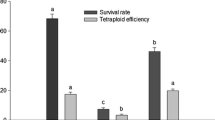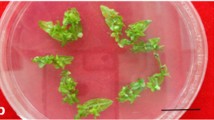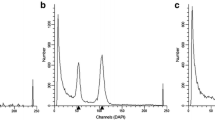Abstract
The aim was to produce tetraploid forms of hybrids of Syringa vulgaris × S. pinnatifolia to restore fertility and enable further breeding to be undertaken. Excised nodal sections of three selections were pre-cultured for 5 days then treated with a range of colchicine concentrations for 1, 2 or 3 days, after which they were washed three times in sterile distilled water and cultured on shoot proliferation medium. Frequent movement to fresh medium was beneficial to survival. Three successive experiments established the range of concentrations of colchicine, 0.05 mM to 0.25 mM, at which tetraploids were likely to be produced. Thus a protocol for the production of tetraploids was established. Cytometric analysis showed that tetraploid forms of two selections were produced.
Similar content being viewed by others
References
Anderson E & Rehder A (1935) New hybrids from the Arnold Arboretum. J. Arnold Arboretum 16: 358–363
Arumuganathan K & Earle ED (1991) Estimation of nuclear DNA content of plants by flow cytometry. Plant Mol. Biol. Rep. 9: 229–233
Beakbane B (1967) The dwarfing effect of a tetraploid sport of MXIII apple rootstock. Rep. E. Malling Res. Stn. for 1966 (pp 96–97)
Dunstan RT (1962) Some fertile hybrids of bunch and muscadine grapes. J. Hered. 53: 299–303
Fiala JL (1988) Lilacs The Genus Syringa (pp 187–188) Helm, Bromley, UK
George EF ed (1996) Plant Propagation by Tissue Culture Part 2 In Practice 2nd ed., (pp 571–1361) Exegetics Ltd, Westbury, UK
James DJ, Mackenzie KAD & Malhotra SB (1987) The induction of hexaploidy in cherry rootstocks using in vitro regeneration techniques. Theor. Appl. Genet. 73: 589–594
Murashige T & Skoog F (1962) A revised medium for rapid growth and bioassays with tobacco cultures. Physiol. Plant 15: 473–497
Rose JB, Kubba J & Tobutt KR (2001) Induction of tetraploidy in Buddleia globosa. Plant Cell Tiss. Org. Cult (in press)
Sax K (1930) Chromosome number and behaviour in the genus Syringa. J. Arnold Arboretum 11: 7–14
Sax K (1945) Lilac species hybrids. J. Arnold Arboretum 26: 79–84
Sax K (1947) Plant breeding at the Arnold Arboretum. Arnoldia 7(2): 9–12
Skinner FL (1948) Hybrid lilacs. Arboretum Bulletin 1(2): 14–16
Tobutt KR (1987) Syringa. Rep. E. Malling Res. Stn. for 1986 (p 109)
Tobutt KR & Longbottom H (1986) Syringa. Rep. E. Malling Res. Stn. for 1985 (p 153)
Webster AD (1996) Cherry rootstock evaluation at East Malling. Acta Hortic. 410: 247-255
Wilson EH (1937) Aristocrats of the garden. Williams and Norgate, London, (p 221)
Author information
Authors and Affiliations
Corresponding author
Rights and permissions
About this article
Cite this article
Rose, J., Kubba, J. & Tobutt, K. Chromosome doubling in sterile Syringa vulgaris × S. pinnatifolia hybrids by in vitro culture of nodal explants. Plant Cell, Tissue and Organ Culture 63, 127–132 (2000). https://doi.org/10.1023/A:1006472101185
Issue Date:
DOI: https://doi.org/10.1023/A:1006472101185




